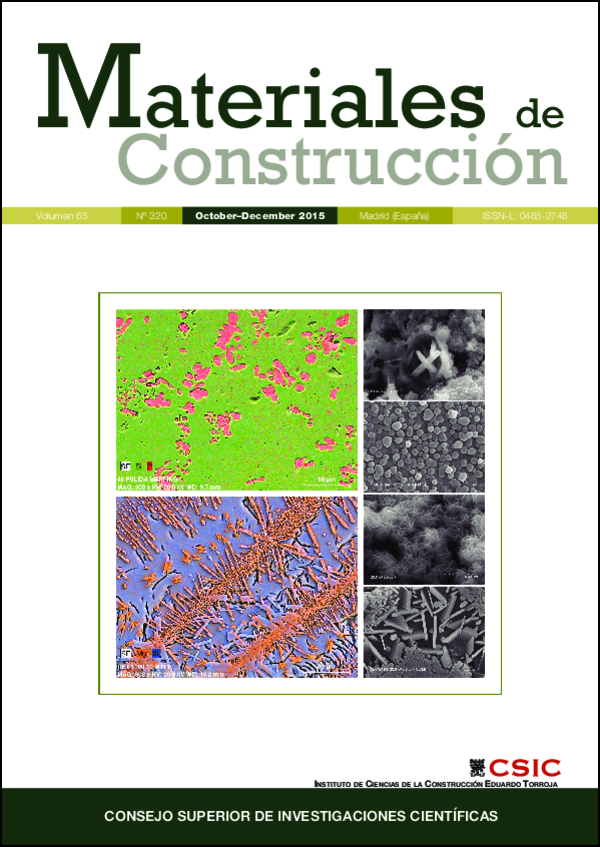Spalling behavior and residual resistance of fibre reinforced Ultra-High performance concrete after exposure to high temperatures
DOI:
https://doi.org/10.3989/mc.2015.00715Keywords:
High Performance Concrete, Temperature, Fiber Reinforcement, Polymer, Mechanical PropertiesAbstract
Experimental results of spalling and residual mechanical properties of ultra-high performance concrete after exposure to high temperatures are presented in this paper. The compressive strength of the ultra-high performance concrete ranged from 160 MPa~185 MPa. This study aimed to discover the effective way to prevent spalling for the ultra-high performance concrete and gauge its mechanical properties after it was subjected to fire. The effects of fiber type, fiber dosage, heating rate and curing condition were investigated. Test results showed that the compressive strength and elastic modulus of the ultra-high performance concrete declined slower than those of normal strength concrete after elevated temperatures. Polypropylene fiber rather than steel fiber was found effective to prevent spalling but affected workability. The effective fiber type and dosage were recommended to prevent spalling and ensure sufficient workability for casting and pumping of the ultra-high performance concrete.
Downloads
References
1. EN 1992-1-1. (2004) Eurocode 2: Design of concrete structures - Part 1-1: General rules and rules for buildings, European Committee for Standardization.
2. EN 1992-1-2. (2004) Eurocode 2: Design of concrete structures - Part 1-2: General rules-structural fire design, European Committee for Standardization.
3. EN 1994-1-1. (2004) Eurocode 4: Design of composite steel and concrete structures - Part 1-1: General rules and rules for buildings, European Committee for Standardization.
4. EN 1994-1-2. (2005) Eurocode 4: Design of composite steel and concrete structures - Part 1-2: General rules - Structural fire design, European Committee for Standardization.
5. Ali, F.A.; Connor, D.O.; Tair, A.A. (2001) Explosive spalling of high-strength concrete columns in fire. Mag. Concr. Res. 53 [3], 197–204. http://dx.doi.org/10.1680/macr.2001.53.3.197
6. Ko, J.; Ryu, D.; Noguchi, T. (2011) The spalling mechanism of high-strength concrete under fire. Mag. Concr. Res. 63 [5], 357–370. http://dx.doi.org/10.1680/macr.10.00002
7. Chen, B.; Liu, J.Y. (2004) Residual strength of hybrid-fiber-reinforced high-strength concrete after exposure to high temperatures. Cem. Concr. Res. 34 [6], 1065–1069. http://dx.doi.org/10.1016/j.cemconres.2003.11.010. http://dx.doi.org/10.1016/j.cemconres.2003.11.010
8. Han, C.C.; Hwang, Y.S.; Yang, S.H.; Gowripalan, N. (2005) Performance of spalling resistance of high performance concrete with polypropylene fiber contents and lateral confinement. Cem. Concr. Res. 35 [9], 1747–1753. http://dx.doi.org/10.1016/j.cemconres.2004.11.013
9. Zeiml, M.; Leithner, D.; Lackner, R.; Mang, H.A. (2006) How do polypropylene fibers improve the spalling behavior of in-situ concrete? Cem. Concr. Res. 36 [5], 929–942. http://dx.doi.org/10.1016/j.cemconres.2005.12.018
10. Hadi, M.N.S. (2007) Using fibres to enhance the properties of concrete columns. Constr. Build. Mater. 21 [1], 118–125. http://dx.doi.org/10.1016/j.conbuildmat.2005.06.028
11. RILEM Technical Committee. (2007) Recommendation of RILEM TC 200-HTC: mechanical concrete properties at high temperatures – modeling and applications, Part 2: stress-strain relation. Mater. Struct. 40 [9], 855–864. http://dx.doi.org/10.1617/s11527-007-9286-1
12. Morita, T.; Saito, H.; Kumagai, H. (1992) Residual mechanical properties of high strength concrete members exposed to high temperature - Part 1: Test on material properties. Summaries of Technical Papers of Annual Meeting, Architectural Institute of Japan, Niigata.
13. Felicetti, R.; Gambarova, P.G.; Rosati, G.P.; Corsi, F.; Giannuzzi, G. (1996) Residual mechanical properties of high strength concretes subjected to high temperature cycles. Proceedings of 4 th International Symposium on Utilization of High Strength/High Performance Concrete, Paris France, 579–588.
14. Liew, J.Y.R.; Xiong, D.X. (2012) Ultra-high strength concrete filled composite columns for multi-storey building construction. Adv. Struct. Eng. 15 [9], 1487–1503. http://dx.doi.org/10.1260/1369-4332.15.9.1487. http://dx.doi.org/10.1260/1369-4332.15.9.1487
15. Xiong, D.X. (2012) Structural behaviour of concrete filled steel tubes with high strength materials. PhD thesis, National University of Singapore.
16. Dias, W.P.S.; Khoury, G.A.; Sullivan, P.J.E. (1990) Mechanical properties of hardened cement paste exposed to temperatures up to 700 °C. ACI Mater. J. 87 [2], 160–166. http://dx.doi.org/10.14359/1981. http://dx.doi.org/10.14359/1981
17. Khoury, G.A. (1992) Compressive strength of concrete at high temperature: a reassessment. Mag. Concr. Res. 44 [161], 291–309. http://dx.doi.org/10.1680/macr.1992.44.161.291. http://dx.doi.org/10.1680/macr.1992.44.161.291
18. Tanyildizi, H.; Coskun, A. (2008) The effect of high temperature on compressive strength and splitting tensile strength of structural lightweight concrete containing fly ash. Constr. Build. Mater. 22 [11], 2269–2275. http://dx.doi.org/10.1016/j.conbuildmat.2007.07.033
19. Castillo, C.; Durrani, A.J. (1990) Effect of transient high temperature on high strength concrete. ACI Mater. J. 87 [1], 47–53.
20. Behnood, A.; Ziari, H. (2008) Effects of silica fume addition and water to cement ratio on the properties of high-strength concrete after exposure to high temperatures. Cem. Concr. Compos. 30 [2], 106–112. http://dx.doi.org/10.1016/j.cemconcomp.2007.06.003
21. ASTM C 469-02 (2002). Standard test method for static modulus of elasticity and Poisson's ratio of concrete in compression. ASTM International, United States.
22. Naus, D.J. (2006) The effect of elevated temperature on concrete material and structures - a literature review. Oak Ridge National Laboratory, U.S. Nuclear Regulatory Commision, Office of Nuclear Regulatory Research, Washington DC.
Published
How to Cite
Issue
Section
License
Copyright (c) 2015 Consejo Superior de Investigaciones Científicas (CSIC)

This work is licensed under a Creative Commons Attribution 4.0 International License.
© CSIC. Manuscripts published in both the printed and online versions of this Journal are the property of Consejo Superior de Investigaciones Científicas, and quoting this source is a requirement for any partial or full reproduction.All contents of this electronic edition, except where otherwise noted, are distributed under a “Creative Commons Attribution 4.0 International” (CC BY 4.0) License. You may read here the basic information and the legal text of the license. The indication of the CC BY 4.0 License must be expressly stated in this way when necessary.
Self-archiving in repositories, personal webpages or similar, of any version other than the published by the Editor, is not allowed.


















